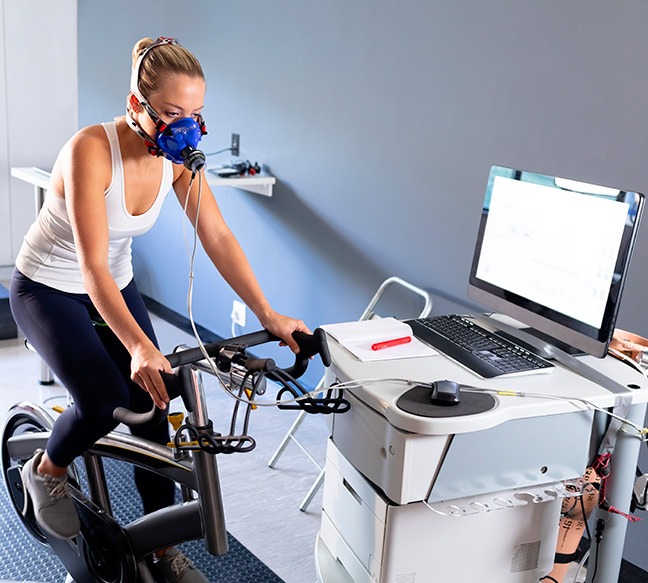What is VO2 Max?
VO2 max, or maximal oxygen consumption, is a measure of the maximum amount of oxygen that an individual can utilize during intense exercise. It is often used as an indicator of aerobic fitness and endurance capacity. During exercise, oxygen is used to produce energy to fuel muscle contractions. VO2 max represents the upper limit of an individual’s ability to transport and utilize oxygen during exercise and is influenced by factors such as cardiovascular health, lung function, and the body’s ability to deliver oxygen to the muscles. VO2 max is typically expressed in milliliters of oxygen per kilogram of body weight per minute (ml/kg/min).
How do I measure my VO2 Max
Measuring VO2 max typically requires specialized equipment and expertise, and it’s often done in a laboratory setting. However, there are a few different methods commonly used to measure VO2 max:
- Maximal Exercise Testing: This is the most accurate method and usually involves a graded exercise test on a treadmill or stationary bicycle. The individual exercises at increasing intensities until they reach exhaustion. During the test, oxygen consumption, carbon dioxide production, and ventilation are measured using a metabolic cart. The point at which oxygen consumption plateaus despite an increase in workload indicates VO2 max.
- Submaximal Exercise Testing: This method involves estimating VO2 max based on submaximal exercise performance. It typically involves exercising at a constant, submaximal intensity (e.g., brisk walking or cycling) while heart rate is monitored. VO2 max is then estimated based on the relationship between heart rate and oxygen consumption.
- Field Tests: There are various field tests that provide estimates of VO2 max using simpler equipment and protocols. One example is the Cooper 12-minute run test, where participants run as far as they can in 12 minutes. VO2 max is estimated based on the distance covered and other factors like age and sex.
- Predictive Equations: There are equations available that estimate VO2 max based on variables such as age, sex, weight, height, and physical activity level. While these equations are convenient, they are less accurate than direct measurement methods.
Where can I get my VO2 Max measured?
It’s important to note that accurate measurement of VO2 max usually requires equipment and expertise that may not be readily available outside of a laboratory or clinical setting.
If you’re interested in knowing your precise VO2 max, Move for Life Physio and Health Hub can refer you for this service. It roughly costs about $200, but email [email protected] for more information. There are also research projects where if you qualify, you might be able to access this service for free as a participant in the study.
How can I improve my VO2 Max?
Improving your VO2 max involves engaging in regular aerobic exercise and implementing specific training strategies designed to challenge and improve your cardiovascular system’s ability to utilize oxygen efficiently. Here are some tips to help you improve your VO2 max:
1) Aerobic Exercise typically Zone 2: Engage in regular aerobic activities such as running, cycling, swimming, or rowing. These activities help increase your heart rate and breathing rate, challenging your cardiovascular system and improving its efficiency.
Zone 2 aerobic exercise refers to a specific intensity level of exercise based on heart rate or perceived exertion. In many systems, such as the five-zone model, it falls within the moderate intensity range, typically corresponding to around 60-70% of your maximum heart rate or a perceived exertion level of 5-6 on a scale of 1-10.
Zone 2 aerobic exercise is characterized by a comfortable pace that allows you to sustain activity for an extended period without feeling overly fatigued. It’s often described as a conversational pace, meaning you can hold a conversation while exercising without feeling breathless.
Here’s how Zone 2 aerobic exercise might be performed:
Warm-Up: Begin with a 5-10 minute warm-up of easy aerobic exercise to gradually increase your heart rate and prepare your body for the upcoming exercise.
Exercise at Zone 2 Intensity: Maintain a steady pace that corresponds to your Zone 2 heart rate or perceived exertion level. This pace should feel comfortable yet challenging enough to elevate your heart rate and breathing slightly.
Duration: Perform aerobic exercise at Zone 2 intensity for an extended period, typically ranging from 30 minutes to several hours, depending on your fitness level and goals.
Cool Down: Finish your workout with a 5-10 minute cool down of easy aerobic exercise to gradually lower your heart rate and help your body recover.
Zone 2 aerobic exercise can be performed with various forms of aerobic activities such as walking, jogging, cycling, swimming, or using cardio machines like elliptical trainers or rowing machines. It’s an effective way to build cardiovascular endurance, improve aerobic capacity, and burn calories while minimizing the risk of overexertion and injury.
2) Interval Training typically Zone 4: Incorporate interval training into your workouts. Interval training involves alternating between periods of high-intensity exercise (e.g., sprinting) and lower-intensity recovery periods (e.g., walking or jogging).
Zone 4 interval training refers to a specific intensity level of exercise based on heart rate or perceived exertion. In many systems, such as the five-zone model, it falls within the high-intensity range, typically corresponding to around 80-90% of your maximum heart rate or a perceived exertion level of 7-8 on a scale of 1-10.
Zone 4 interval training involves alternating between periods of high-intensity exercise and periods of lower-intensity recovery. These intervals are shorter in duration compared to lower intensity zones. During Zone 4 intervals, you should be working close to your maximum effort, feeling challenged and breathless.
Here’s how Zone 4 interval training might be structured:
Warm-Up: Begin with a 10-15 minute warm-up of easy aerobic exercise to prepare your body for the upcoming intensity.
Interval Periods: Perform intervals of high-intensity exercise lasting anywhere from 1 to 5 minutes, depending on your fitness level and goals. During these intervals, aim to work at a pace that feels very challenging but sustainable for the duration of the interval.
Recovery Periods: After each high-intensity interval, allow yourself a period of active recovery. This could involve slowing down your pace or reducing the resistance, depending on the type of exercise you’re doing. Recovery periods are typically shorter than the work intervals, lasting around half the duration or less.
Repeat: Complete multiple intervals and recovery periods according to your workout plan. Beginners may start with just a few repetitions, while more experienced individuals might do several sets.
Cool Down: Finish your workout with a 10-15 minute cool down of easy aerobic exercise to gradually lower your heart rate and help your body recover.
Zone 4 interval training can be performed with various forms of aerobic exercise such as running, cycling, swimming, or rowing. It’s an effective way to improve cardiovascular fitness, increase VO2 max, and enhance overall endurance. However, it’s essential to tailor the intensity and duration of your intervals to your fitness level and goals, and always listen to your body to avoid overexertion and injury.
3) High-Intensity Interval Training (HIIT): HIIT involves short bursts of intense exercise followed by brief recovery periods. This method can be particularly effective in improving VO2 max and overall cardiovascular fitness in a shorter amount of time compared to steady-state exercise.
Here’s how Zone 4 interval training might be structured:
Warm-Up: Start with a 5-10 minute warm-up of light aerobic exercise to prepare your muscles and cardiovascular system for the upcoming intensity. You can walk, jog, cycle, or perform dynamic stretches to gradually increase your heart rate and loosen up your muscles.
Interval Sets: Choose your high-intensity exercise and determine the work-to-rest ratio. A common ratio is 1:1 (equal work and rest periods), but you can adjust it based on your fitness level and goals.Perform several rounds of intervals, alternating between high-intensity work and rest or low-intensity recovery. Each interval set can consist of 4-8 intervals, depending on your fitness level and the length of each interval.
Example: If you’re doing 30-second sprints followed by 30 seconds of rest, you might start with 4-6 sets and gradually increase the number of sets as you progress.
High-Intensity Exercise: Choose high-intensity exercises that elevate your heart rate and engage large muscle groups. Examples include sprinting, jumping jacks, burpees, mountain climbers, high knees, or cycling at maximum effort.
Perform each high-intensity interval with maximum effort, aiming to push yourself close to your limits during the work periods.
Rest or Low-Intensity Recovery: During the rest or recovery periods, allow your heart rate to come down and your breathing to return to a comfortable level. You can walk, jog slowly, or perform light aerobic exercises.
The purpose of the recovery periods is to help you recover enough to perform the next high-intensity interval with quality effort.
Cool Down: Finish your HIIT session with a 5-10 minute cool down of light aerobic exercise to gradually lower your heart rate and help your body recover. You can walk, jog, or perform static stretches to improve flexibility and reduce muscle soreness.
Remember to listen to your body, modify exercises as needed, and consult with a fitness professional if you have any health concerns or injuries. HIIT can be an effective way to improve cardiovascular fitness, burn calories, and boost metabolism in a relatively short amount of time, but it’s essential to perform it safely and effectively.
4) Strength Training: Don’t neglect strength and resistence training. Building muscular strength and endurance can enhance your overall fitness level, which can indirectly contribute to improvements in VO2 max.
5) Proper Nutrition and Hydration: Fuel your body with a balanced diet rich in carbohydrates, proteins, healthy fats, and micronutrients. Stay hydrated before, during, and after exercise to support optimal performance and recovery. We have a dietitian, in the clinic who can assist with these needs.
6) Rest and Recovery: Allow your body adequate time to rest and recover between workouts. Overtraining can hinder progress and increase the risk of injury. Incorporate rest days into your training schedule and prioritize quality sleep to support recovery and adaptation.
By incorporating these strategies into your training regimen and staying consistent with your workouts, you can gradually improve your VO2 max and enhance your overall cardiovascular fitness. Remember to listen to your body, adjust your training as needed, and consult with a fitness professional if you have any specific health concerns or conditions.
Neeraj Kochhar
SENIOR PHYSIOTHERAPIST


